Endemic species are species found exclusively in a particular area. Dryland ecosystems usually feature a lot of endemic species, as species have had to adapt to environments where food and water availability can be scarce and temperatures fluctuate greatly.
The Kalahari Desert is an arid and semi-arid area, over four times the size of Great Britain, stretching over most of Botswana, and parts of Namibia and South Africa. Temperatures vary drastically in the Kalahari, going below zero on winter nights and reaching as high as 40 degrees Celsius during summer days. Long periods of drought intersect with rare but violent thunderstorms. The Kalahari's endemic species, or the species that can only be found in the Kalahari, have developed unique ways to feed themselves, go long periods without water and to survive extreme temperatures.
| Meerkat |
 |
The best-known meerkat is certainly Timon, one of the main characters in the Disney animated picture The Lion King. Although Timon hung out with a lion and a warthog in the movie, meerkats usually stick together in large groups called "mobs" or "gangs". |
 | They mainly prey on insects and like other members of the mongoose family, they are immune to venom allowing them to eat scorpions and snakes without being poisoned.
|
 |
Meerkats have a hairless patch on their bellies that they use to absorb the heat after cold desert nights. |
|
 | | 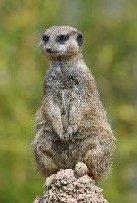 |
| Gemsbok |
 |
The Gemsbok is a large African antelope with very long horns, sometimes used in defence against the Kalahari lions. |
 |
They can survive days or even weeks without drinking water. They rely on some of the Kalahari's plants that have also adapted to the dry conditions and either store water or have mechanisms to prevent excess water loss. |
 |
The plants gradually release dew during the hotter parts of the day. Some plants increase their water content by 25 to 40 percent, so when the gemsbok feed late at night or early in the morning, the plants provide them with both food and water. |
|
 |
Kalahari Lion
 |
The Kalahari lion is a sub-species that behaves and looks different from other lions as a result of its adaptation to the Kalahari environment. |
 |
Compared to other lions, it lives in smaller groups, covers larger home territories and hunts smaller prey. One of its favourite dishes is the gemsbok, but when they are not available lions also eat antelopes, porcupines and other small mammals. |
 |
The Kalahari lion is lighter and males have black manes. |
|
 | | 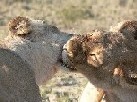 |
Social weavers
 |
Social weavers are a sub-species of the weaver birds, named for their ability to weave very large communal nests. |
 |
The communal nests can measure up to 6 meters long and 2 meters high, and can weigh as much as 1,000 kg while housing up to 300 birds. The nests are built with insulated walls to maintain a stable temperature inside the nest to keep the weavers warm at night and cool during the day. |
 |
Like the gemsbok, social weavers seldom need to drink water. |
|
 | |  |
| Camelthorn tree |
 |
The camelthorn tree is an acacia tree endemic to the Kalahari region. It is practically the only tree that has adapted to the Kalahari environment and is thus a key component of the ecosystem. |
 |
The camelthorn tree provides nutrients for other plants and shrubs, which grow more densely around the trees, while their leaves provide food for animals. The shade of the tree also serves as a refuge for animals during the day and the social weavers build their nests in its branches. |
|
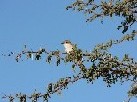 | | 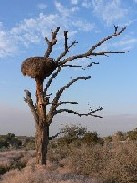 |
| Hoodia cactus |
 |
The Hoodia cactus thrives in extremely high temperatures, and takes many years to mature. |
 |
The San people, who have inhabited the Kalahari for more than 22,000 years as hunters-gathers, have traditionally eaten this cactus to stave off hunger and thirst during long hunting trips or times of drought. |
 |
A few years ago, scientists identified the molecule present in the Hoodia cactus which fools the brain into believing it is not hungry. Pharmaceutical companies have since started conducting clinical tests with the intent to sell diet pills using the unique molecule featured by Hoodia. The San people, who currently live in poverty, are demanding a share of the profits for the use of their traditional knowledge and for the right to access this resource. |
|
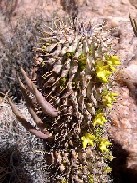 |
All the above species are interdependent. The Kalahari Lion feeds on the gemsbok. The gemsbok feeds on plants that hold water such as the Hoodia cactus. The weaver makes its nest in the camelthorn tree, and so on. When one species becomes extinct, it has a ripple effect on a number of other species. Although none of the above species are currently threatened by extinction, others are not as lucky. Endangered species in the Kalahari include the African wild dog, the African wild cat, the Cape vulture and the aardvark. However, generally speaking, endemic species are more vulnerable to extinction than other species as they are able to survive only under very specific environmental conditions. Thus efforts must be made to ensure unique drylands species such as the meerkat, the gemsbok, the Kalahari lion, social weavers, the camelthorn tree and the hoodia cactus continue to thrive.